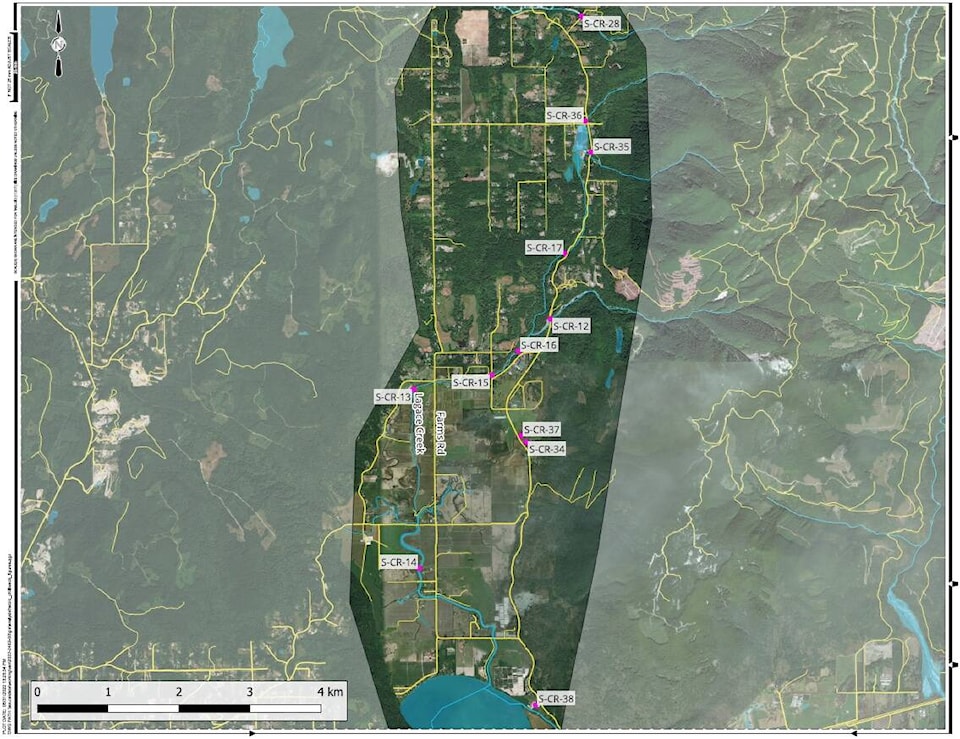As Hatzic recovers from the 2021 atmospheric river, climate change remains an ongoing obstacle for the region.
Hatzic Watershed Stewardship Team co-chair Rick McKamey says work to repair damage is going well, but more needs to be done moving forward.
“I hear the word resilience and I start to shiver because we have a lot of work to do before we understand how to become resilient, let alone applying work to be resilient,” McKamey said.
Over a dozen sites were identified for repairs after the atmospheric river caused extensive flooding and sediment movement in the region in November 2021.
The province’s Hatzic Valley Emergency Works Program has completed work at five sites to date with more locations on the way this year, according to the program’s January newsletter.
The $21.8-million project includes the removal of sediment and debris from waterways, culverts, bridge crossings and riverbanks, along with the restoration and repair of eroded creek banks.
Of the sites identified, work has been completed at Pattison Creek, Carratt Creek, Davies Creek, Eng Creek and McNab Creek with design work also completed for several other sites.
“It’s difficult because of the challenges that we have out in Hatzic,” McKamey said. “But the work that has and is taking place out there is under the Emergency Management and Climate Readiness funds — the disaster recovery fund. It’s all been based on the 2021 atmospheric river and doing what we can to ensure … the debris that is filled in the system is removed back to what it was prior to the 2021 event. So, it’s going as best as we could possibly have it go.”
This year, North Herford Creek, South Herford Creek, Lagace Creek and Saprano Creek are slated for design and construction.
Construction on Lagace Creek had to be postponed from 2023 to 2024 due to the presence of spawning salmon. According to the newsletter, additional analysis needs to be carried out for Lagace Creek from Dale Road to Hatzic Lake to determine the appropriate path forward.
At Lagace Creek from Pattison to Farms Road, sediment removal is occurring in streams that are also home to various salmon and trout species that need to be protected.
“Design elements have been incorporated where possible to enhance the habitat conditions, including sediment removal in selected locations by creating pools and riffles to support fish during varying flow conditions and using erosion protection measures utilizing vegetation (bioengineering) to provide shade, water temperature variability and nutrients and food sources (insects) that enhance fish habitat,” the Emergency Works Program newsletter reads.
To protect the species, the sediment removal process must be done at a certain time with the next window of opportunity in August 2024.
McKamey says funding from the Ministry of Emergency Management and Climate Readiness won’t last forever.
“We’re coming to the sunset of that fund, and how do we work with the transition? Because [Hatzic] was affected horribly by the 2021 atmospheric river event, but a lot of the challenge in the Hatzic Valley — it’s ongoing,” McKamey said.
The cumulative impacts of climate change, growth, fibre extraction and mining on the hillside are challenging for the region, McKamey says.
“Climate change is the key here. It’s what’s driving the greatest challenges that we have and that’s the way that the water is coming off of those slopes. Dealing with that has become the most critical thing through the Fraser Valley here — especially on the north side of the Fraser River — where we have all of these south-facing slopes,” he said.
McKamey says before the stewardship team can adapt to the changing climate, it needs to understand what it has to adapt to. The Hatzic Watershed Stewardship Team has applied to the Investment Agriculture Foundation of B.C. (IAF) to support a more robust management plan for Hatzic Lake.
The new plan would incorporate the tributaries of Hatzic Lake, along with upgrading the 1948 pump station and lifting electrical kiosks.
“[Past data] hasn’t taken us up through the tributaries to understand what is changing in those slopes, why [it’s] changing and what we need to do to adapt to it. Once we figure that out, then we can build a resiliency plan,” McKamey said.
During high flows and flooding in the future, McKamey hopes there’s less of an impact on human life, infrastructure, agriculture and habitats. He says it will be important to ensure that water gets to where it needs to be.
“You look down at Washington State and what they’re doing with floodplains by design and the efforts here in British Columbia – it’s designing our systems to allow for flooding because we have no control over what climate change is doing to us, but we do have some control over how we prepare ourselves and how we mitigate the disaster [and] mitigate the challenges that are caused by these rising waters and these atmospheric events that we’re dealing with,” McKamey said.
McKamey still has challenges with the word resilience as it relates to flooding.
“Ultimately that’s our goal — to become climate resilient. And [if] we become climate resilient, then we’ll be more flood resilient. Nothing that we’ll do will curb the flooding,” he said.
READ MORE: Environmental concerns ‘fall to the wayside’ in Hatzic
